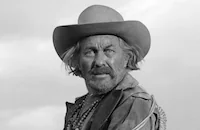Invitation to a Gunfighter

Brief Synopsis
Cast & Crew
Richard Wilson
Yul Brynner
Janice Rule
Brad Dexter
Alfred Ryder
Mike Kellin
Film Details
Technical Specs

Synopsis
Returning to Pecos, New Mexico, at the end of the Civil War, Confederate veteran Matt Weaver discovers his property appropriated and sold by banker Brewster; his former fiancée, Ruth, married to a one-armed Union soldier; and his neighbors, Yankee sympathizers, aligned against him. After Weaver shoots in self defense the new owner of his farm, Brewster hires the notorious Jules Gaspard d'Estaing to eliminate him. The gunman, an enigmatic educated mulatto, proves uncontrollable, and Brewster attempts to hire Weaver to slay d'Estaing. In the ensuing confrontation, the gunman provokes Weaver, who then slays both d'Estaing and Brewster.

Director
Richard Wilson
Cast

Yul Brynner
Janice Rule

Brad Dexter
Alfred Ryder
Mike Kellin

George Segal
Clifford David

Pat Hingle
Bert Freed
Curt Conway
Clifton James
Clarke Gordon
Arthur Peterson

Strother Martin
Gertrude Flynn
John Alonzo
William Hickey
Gerald Hiken
Dal Jenkins
Crew
Robert Clatworthy
Hal Goodman
Austen Jewell
Robert C. Jones
Larry Klein
Stanley Kramer
Joseph Macdonald
David Raksin
Rodd Redwing
William Russell
Alvin Sapinsley
Ivan Volkman
Elizabeth Wilson
Richard Wilson
Richard Wilson

Film Details
Technical Specs

Articles
Invitation to a Gunfighter
Not a typical Western by any stretch of the imagination, Invitation to a Gunfighter (1964) is a psychological frontier drama with an unusual twist - the hired gun is a literate, highly educated gentleman of Creole ancestry with a hatred for whites. The film not only plays up the race issue but also the sense of alienation and dissolution that affected towns where families fought on both sides of the Civil War. Imagine a Western as interpreted by the Actor's Studio and you have a pretty good idea of what to expect. The fact that Invitation to a Gunfighter has a distinct theatrical flavor is not surprising. Richard Wilson, the co-writer, producer and director, learned his craft as an actor in The Mercury Theatre and in several Orson Welles films. His theatre training is evident throughout the film from its staging to the screenplay which provides dramatic soliloquies for some of the central players and elements of Greek tragedy. Adding to the "Off-Broadway" quality of the film are the performances: George Segal takes a 'Method' actor approach to his besieged Southerner while Yul Brynner alternates between moments of cool sophistication (he recites poetry and plays the spinet) and intense brooding.
Most of Invitation to a Gunfighter, which was executive produced by Stanley Kramer, was filmed on the Universal backlot and the old Psycho house was used as the set for Sam Brewster's home. A few actors in the supporting cast will also be instantly recognizable to Western fans; Brad Dexter was one of the hired guns of The Magnificent Seven (1960); Strother Martin appeared in the Sam Peckinpah Westerns, The Wild Bunch (1969) and The Ballad of Cable Hogue (1970); and Russell Johnson, most famous for his role as the Professor on Gilligan's Island, made several B-Westerns in the fifties including Seminole (1953) and Many Rivers to Cross (1955).
However, if you expect pure action from a Western like blazing gunfights, barroom brawls, and cattle stampedes, Invitation to a Gunfighter is NOT for you. Sure, the film has the prerequisite shootouts and killings and violent confrontations. But the overall style of the movie is closer to a Eugene O'Neill drama than a six-gun oater like Dodge City (1939). After all, when was the last time you saw a feared gunfighter publicly best his rival - not in a showdown - but through a demeaning lesson in French pronunciation?
Producer/Director: Richard Wilson
Screenplay: Richard Wilson, Elizabeth Wilson, Hal Goodman (story), Larry Klein (story)
Production Design: Robert Clatworthy
Cinematography: Joseph MacDonald
Editing: Robert C. Jones
Music: David Raksin
Costume Design: Paula Giokaris
Cast: Yul Brynner (Jules Gaspard d'Estaing), Janice Rule (Ruth Adams), George Segal (Matt Weaver), Alfred Ryder (Doc Barker), Clifford David (Crane Adams), Pat Hingle (Sam Brewster), Bert Freed (Sheriff), Strother Martin (Fiddler), Clifton James (Bartender), William Hickey (Jo-Jo).
C-93m.
by Jeff Stafford

Invitation to a Gunfighter
Quotes
I'll tell you what I am... and what you are. I'm a man with a gun, and you're drunk.- Jules Gaspard d'Estaing
You got him in the arm- Sam Brewster
I aimed for his Reb heart.- Crane Adams
Your performance is never up to your intentions.- Sam Brewster
I've got a half dollar that says he's a skinny runt tied to a big gun. You know, them skinny ones is the ones that get handy with a gun. They got to, you know.- Townsman
Is your name Jewel?- Sam Brewster
No.- Jules Gaspard d'Estaing
The hotel register....- Hotel Owner
My name is- Jules Gaspard d'Estaing
Jewels...Gasperd...Die-es-ting- Sam Brewster
Jules...soft j, silent s...Gaspard...silent d...d'Estaing...just a touch of dipthong.- Jules Gaspard d'Estaing
That's my mother's grave out there, Ruth. I planted them vines on the porch. I'll live here until I die...sooner or later. However, as long as I live, I'll fight the whole town for the right to die here.- Matt Weaver
Trivia
Miscellaneous Notes
Released in United States Winter January 1, 1964
Released in United States Winter January 1, 1964













